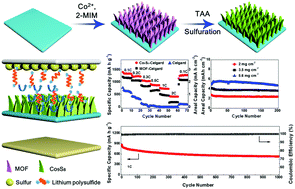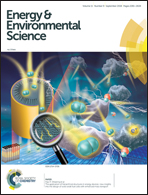Vertical Co9S8 hollow nanowall arrays grown on a Celgard separator as a multifunctional polysulfide barrier for high-performance Li–S batteries†
Abstract
Lithium–sulfur (Li–S) batteries have been regarded as one of the most promising next-generation energy-storage devices, due to their low cost and high theoretical energy density (2600 W h kg−1). However, the severe dissolution of lithium polysulfides (LiPSs) and the fatal shuttle effect of the sulfur cathode seriously hinder the practical applications of Li–S batteries. To address such issues, we present here, for the first time, a novel metal organic framework (MOF)-derived Co9S8 nanowall array with vertical hollow nanoarchitecture and high electrical conductivity, which is grown in situ on a Celgard separator (Co9S8–Celgard) via a feasible and scalable liquid-reaction approach, as an efficient barrier for LiPSs in Li–S batteries. Benefiting from the direct in situ growth of vertical Co9S8 hollow nanowall arrays as a multifunctional polar barrier, the Co9S8–Celgard separator possesses large surface area, excellent mechanical stability, and particularly strong LiPS-trapping ability via chemical and physical interactions. With these advantages, even with a pure sulfur cathode with a high sulfur loading of 5.6 mg cm−2, the Li–S cells with the Co9S8–Celgard separator exhibit outstanding electrochemical performance: the initial specific capacity is as high as 1385 mA h g−1 with a retention of 1190 mA h g−1 after 200 cycles. The cells deliver a high capacity of 530 mA h g−1 at a 1C rate (1675 mA g−1) even after an impressive number of 1000 cycles with an average capacity fade of only 0.039% per cycle, which is promising for long-term cycling application at high charge/discharge current densities, and pouch-type Li–S cells with the Co9S8–Celgard separator display excellent cycling performance. When the optimized cathode with the sulfur loading in well-designed yolk–shelled carbon@Fe3O4 (YSC@Fe3O4) nanoboxes is employed, the cell with Co9S8–Celgard delivers a high initial capacity of 986 mA h g−1 at a 1C rate with a capacity retention as high as 83.2% even after a remarkable number of 1500 cycles. This work presents a strategy to grow on the separator a multifunctional polar interlayer with unique nanoarchitecture and high conductivity to chemically and physically trap the LiPSs, thus significantly enhancing the performance of Li–S batteries.



 Please wait while we load your content...
Please wait while we load your content...